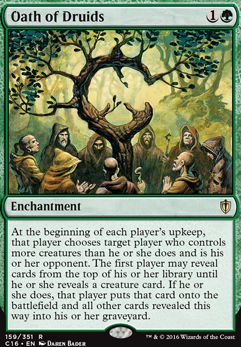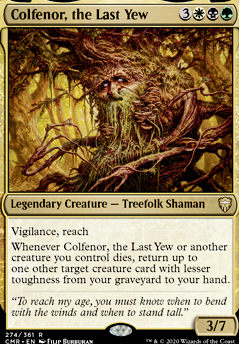
Druidic Lore and Philosophy
Commander / EDH BGW (Abzan, Junk) Druid Multiplayer Sacrifice Theme/Gimmick Treefolk Vorthos
Creature (33)
- 1x Ancient Lumberknot
- 1x Battlewand Oak
- 1x Blood Researcher
- 1x Burlfist Oak
- 1x Dina, Soul Steeper
- 1x Druid of Purification
- 1x Dungrove Elder
- 1x Fyndhorn Elves
- 1x Greenweaver Druid
- 1x Heartwood Storyteller
- 1x Kurbis, Harvest Celebrant
- 1x Lifespring Druid
- 1x Llanowar Loamspeaker
- 1x Naga Vitalist
- 1x Nemata, Primeval Warden
- 1x Orchard Strider
- 1x Orchard Warden
- 1x Paradise Druid
- 1x Rosethorn Acolyte
- 1x Sakura-Tribe Elder
- 1x Sapling of Colfenor
- 1x Scaled Herbalist
- 1x Scurry Oak
- 1x Seedguide Ash
- 1x Somberwald Sage
- 1x Spore Frog
- 1x Sumala Woodshaper
- 1x Tilling Treefolk
- 1x Verdeloth the Ancient
- 1x Warden of the Woods
-
1x
Willow Geist

- 1x Witherbloom Apprentice
- 1x Witherbloom Pledgemage
Land (36)
- 1x Arctic Treeline
- 1x Canopy Vista
- 1x Command Tower
- 1x Darkmoss Bridge
- 7x Forest
- 1x Golgari Rot Farm
- 1x Idyllic Grange
- 1x Murmuring Bosk
- 1x Orzhov Basilica
- 6x Plains
- 1x Sandsteppe Citadel
- 1x Selesnya Sanctuary
- 5x Swamp
- 1x Temple of Malady
- 1x Temple of Silence
-
1x
Thornglint Bridge

- 1x Thriving Grove
- 1x Thriving Heath
- 1x Thriving Moor
- 1x Undergrowth Stadium
- 1x Witch's Cottage
Enchantment (9)
Commander (1)
Sorcery (12)
- 1x Cultivate
- 1x Diabolic Tutor
- 1x Druidic Ritual
- 1x Grow from the Ashes
- 1x Harmonize
- 1x Healing Technique
- 1x Kodama's Reach
- 1x Primal Command
- 1x Read the Bones
- 1x Roots of Wisdom
- 1x The Great Aurora
- 1x Witherbloom Command
Artifact (5)
- 1x Ceremonial Knife
- 1x Druidic Satchel
-
1x
Moss Diamond

- 1x Selesnya Cluestone
-
1x
Talisman of Resilience

Instant (4)
Suggestions
Updates Add
Comments
Attention! Complete Comment Tutorial! This annoying message will go away once you do!
Important! Formatting tips — Comment Tutorial — markdown syntax
Please login to comment
97% Casual
Competitive
| Top Ranked |
|
| Date added | 1 year |
| Last updated | 1 year |
| Legality | This deck is Commander / EDH legal. |
| Rarity (main - side) | 2 - 0 Mythic Rares 27 - 0 Rares 23 - 0 Uncommons 30 - 0 Commons |
| Cards | 100 |
| Avg. CMC | 3.36 |
| Tokens | Blood, Food, Saproling 1/1 G, Squirrel 1/1 G |
| Folders | Theme Decks on Another Level, Fun and Interesting Deck Ideas |
| Votes | |
| Ignored suggestions | |
| Shared with | |
| Views |

